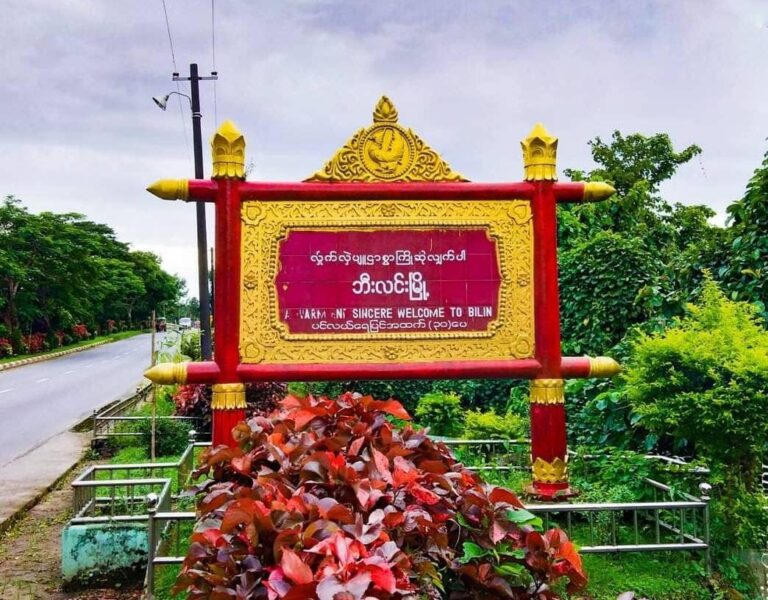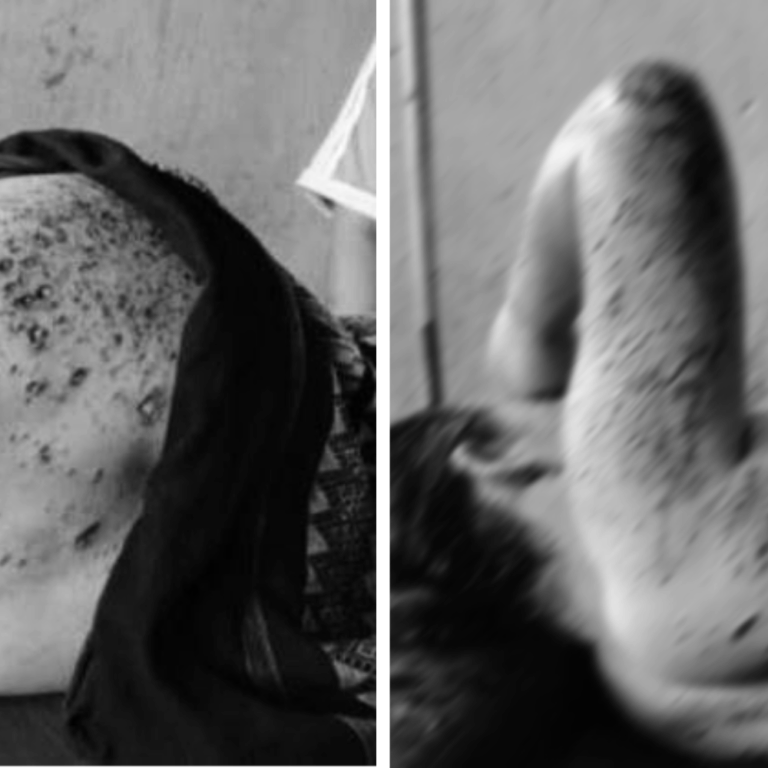 Grass leaves cover the small hut and the floor is laid with bamboo. The poles are only the thickness of a thin man’s wrist. The hut has three rooms and it was built as many months ago. In the bedroom there is one blanket and two pillows; in the kitchen there are two pots and four dishes. A woman named Mi Kyae is sleeping on the floor as two children play on the ground near her. Their situation is not so different from the situation of many displaced people and refugees on the Thai-Burma border.
Grass leaves cover the small hut and the floor is laid with bamboo. The poles are only the thickness of a thin man’s wrist. The hut has three rooms and it was built as many months ago. In the bedroom there is one blanket and two pillows; in the kitchen there are two pots and four dishes. A woman named Mi Kyae is sleeping on the floor as two children play on the ground near her. Their situation is not so different from the situation of many displaced people and refugees on the Thai-Burma border.
The New Mon State Party (NMSP) has had a ceasefire with Burma’s State Peace and Development Council (SPDC) government for around 13 years, but the villagers still suffer from war. Conflict is still happening in southern Mon State and Tanessarim Division because Mon and Karen rebels are active in the area. The SPDC calls the region a “black area,” and treats it as a free fire zone.
SPDC soldiers and rebels are still fighting in the area. And villagers are still suffering. A hundred thousand villagers have left their homes and moved to places they hope will be safer. But the displaced people face many problems in their new homes; problems related to food, health care, education, land rights, employment and travel. In this situation, women and children suffer more than men because men are usually the main breadwinners who have to work and consequently they can get more food and more and better health care.
Mi Kyae’s family and other families escaped from their village last October. When they left, each family had to pay 5,000 Kyat to village authorities and had to lie about visiting another village. When her group left the village they had to walk for three days and two nights. They walked from Ye to Halockhani, which is a Mon resettlement camp for returned refugees. The group crossed many camps but they could not live in these camps because no one knew them and they had no one to depend on.
Mi Kyae’s family is just one of the families which have been displaced from Tanessarim Division. Her family was displaced from Cha Pon village and now they are based in a village in We Jar Tha village, Sangklaburi District, Kanchanaburi Province, Thailand. Mi Kyae’s family has four members: Mi Kyae, her two children and her husband. They hoped to get a better life in the border area.
Mi Kyae’s group stayed in We Jar Tha village for a month before some went back. Some returned because they had property in their home village, others wanted to go back because they knew they would face a difficult life in We Jar Tha. Only Mi Kyae’s family did not return.
Since her family arrived in this area three months ago, they have faced many kinds of problems. The struggled to find food and health care, land for building a house and employment. When they first arrived in We Jar Tha they had no place to live, but fortunately the Mon Relief Development Committee (MRDC) helped them find a place to stay. Mi Kyae has had to find a job on her own.
In We Jar Tha village, only Mi Kyae’s husband can work and Mi Kyae cannot work because her husband’s employer will not allow women to work on his farm. Her husband can work only one or two weeks per month and he can only earn 130 baht per day. He is paid unfairly low wages because he is an illegal worker in Thailand. Legal foreign workers can earn 170 to 180 Baht per day and Thais can earn 200 Baht per day.
Mi Kyae has no idea how to get more income and she also does not dare to go outside because she is afraid that the Thai police will arrest her and put her in jail. She has no job and she only works in the house preparing food and looking after her children.
“Now that the prices of rice and cooking materials are so expensive and my income is so low I have no idea how to continue in life. Sometimes I have not enough food for my family and I need to give my husband more food than us because he has to work. My two children also have to get enough food. I always eat less.”
While Mi Kyae talked about her situation a motorbike came and the driver shouted to her, “Do you want some fish? If you have no money you can give me tall-grass.” In January and February, many people sell tall grasses for broom making. Mi Kyae stood up from her place and went to the motorbike and her children also ran along side her in their bare feet and dirty clothes. She picked up one small bag of fish and then came back to her place and sat down again. The wind was blowing strongly and there was a strong smell of pig shit. When I looked at the two children I asked her how old they were. She replied that the eldest was five years old and the younger was four. The children did not look their age because they were little and thin and small.
She looked at her children and worried about their education. “My daughters are at the age for school,” she said. “But I cannot let them to go to school. I have no idea how can I send my daughters to school because I have no money.”
Mi Kyae talked about her home village in Burma. “In my village we had to do forced labor for the army every day and my husband could not work for our family. We did not have enough food to eat and our plantation was confiscated. Women were raped while their husbands were away carrying soldiers’ things [as conscripted porters].”
In her village the rebel groups also demanded money and food from the villagers. Villagers have to give to each side, soldiers rebel and SPDC alike. If the soldiers heard that villagers gave food and money to the rebel groups they would execute or torture suspected villagers. These things are common in the black areas, My Kyae said.
The numbers of soldiers is increasing and villagers have had to take more and more responsibility for SPDC and rebel soldiers. Villagers have to work more because they have to pay illegal taxes to both sides. These conflicts affect the villagers so over a hundred thousand have had to leave home because of such suffering.
“Lives in the southern part of Ye Township are like grass – while the buffalo are fighting the grass is always destroyed,” Mi Kyae said with tears in her eyes.
“In the Southern Part of Ye Township there are the most human rights abuses in all Mon State,” agreed Nai Aue Mon from the Human Rights Foundation of Monland (HURFOM). HURFOM works to extensively document reports about Human Rights abuses in Mon areas like Mon State and Tenasserim Division.
Many of the people displaced by conflict and human rights abuses do not live in the refugee camps or resettlement sites. Some of them live in other places around the border area and receive no help from the MRDC, which provides support to residents of resettlement sites. The MRDC can only focus on the people who live in the official sites, even though all displaced people are in need. The MRDC is only able to help people who live on the Burmese side of the border, not those who live on the Thai side. Mi Kyae’s family lives on the Thai side so she has not had much help from the MRDC since she arrived in We Jar Tha.
“One day my child was sick but I did not dare to go to the hospital. People in We Jar Tha said to me that if I went to the hospital the police would arrest me and put me in jail. I had to send my daughter to the outside health worker and it was very expensive. The health worker just gave my daughter one injection and ten tablets of medicine and I had to give her 500 baht.”
Mi Kyae’s family hoped to get a better life in the border area but they face many difficulties. They want to go back to their home village and live their lives in peace. They know that they will probably never go back again, but they hope that one day if Burma becomes democratic then they could go back and live there happily. Thousands upon thousands of families like Mi Kyae’s hope to go back to their hometowns, but nobody knows how long the conflict and human rights abuses will continue.
In one day, one week, one month, one year, one life or one generation we will go back to our home.



